Walking Through Athens: A Cultural Journey Beyond the...
From historic landmarks to edgy street...
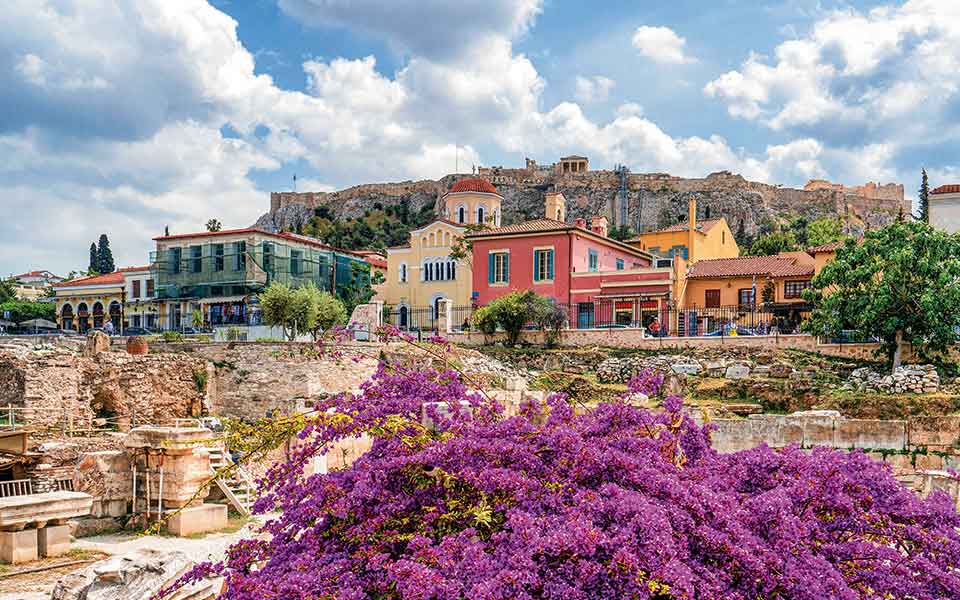
The archaeological site of Hadrian's Library, draped in bougainvillea, and, in the background, the Acropolis.
© Perikles Merakos
There’s a nearly infinite number of ways to uncover the myriad faces of Athens. Our chosen journey is a circular route, beginning and ending at the primary entrance to the National Garden – a stone’s throw away from the Greek Parliament. This verdant haven is a popular rendezvous spot for locals and a top choice for tourists seeking a picture-perfect snapshot in the heart of the city. Many visitors pose under the towering Washingtonia robustas, palm trees endemic to southwestern US and northwestern Mexico.
These botanical gems were planted in 1842 by the hand of Queen Amalia, the country’s first queen. Indeed, the creation of the Royal Garden, as it was initially known, remains one of her most significant contributions to the country. Housing ancient ruins, a quaint duck pond, and a small zoo, the Garden is a treasure trove awaiting exploration but perhaps best saved for the end of your route, as it stays open until sunset.
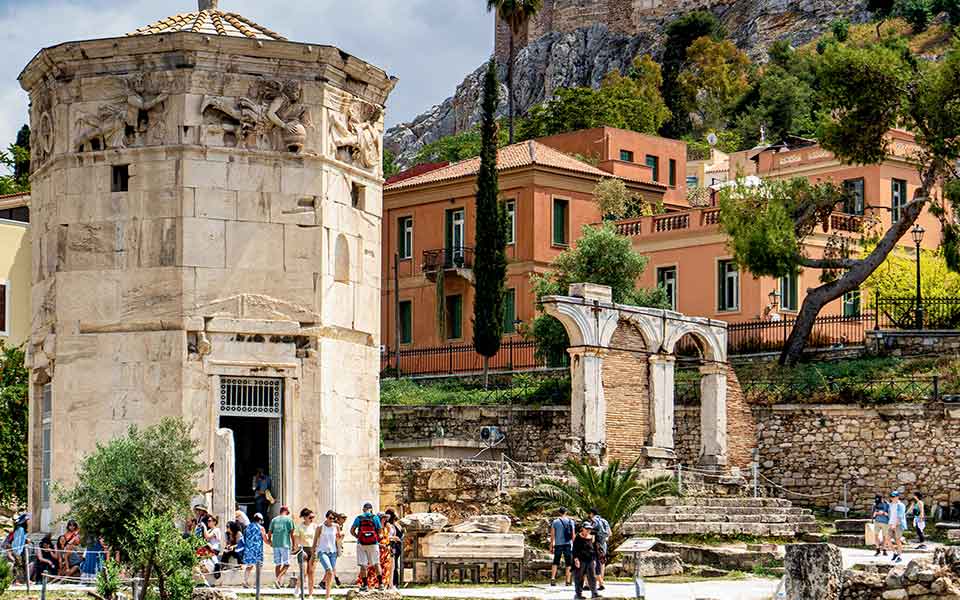
The Tower of the Winds dates from the 1st century BC.
© Perikles Merakos
Departing from the Garden, first cross stately Queen Amalia Avenue and then make your way leftwards towards Plaka, the enchanting “Neighborhood of the Gods.” Roughly 400 meters away, where Queen Amalia and Philhellenon Street intersect, you’ll come across the Anglican Church of St. Paul. A neo-Gothic sanctuary designed by renowned Greek architect Stamatis Kleanthis and built between 1838 and 1843 under the watchful eye of Danish architect Hans Christian Hansen, it’s one of the few churches in Greece that occasionally plays host to concerts and other cultural events. The church is the first stop on our journey.
Heading deeper into the heart of Athens, you’ll navigate Tsatsou Street to enter the charming district of Plaka. This tourist hub is affectionately dubbed the city center’s architectural time capsule, as many of its structures date from the 19th century. Plaka enchants visitors with its narrow lanes evocative of a picturesque Greek island. In this labyrinthine neighborhood, a GPS becomes your trusted ally, guiding you to gems worth exploring.
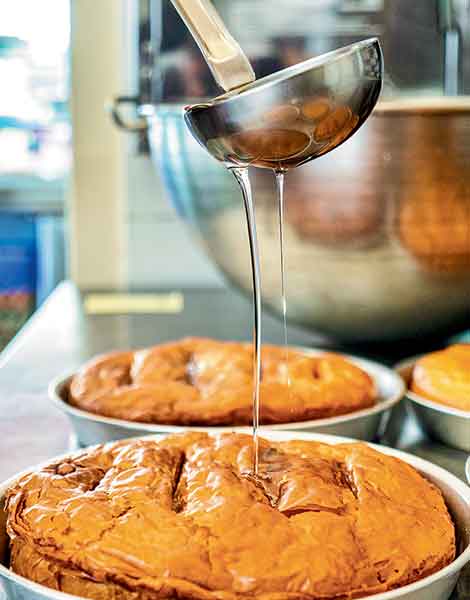
Galaktoboureko, a traditional dessert dating back to the days of Ottoman rule, is heartily recommended.
© Perikles Merakos
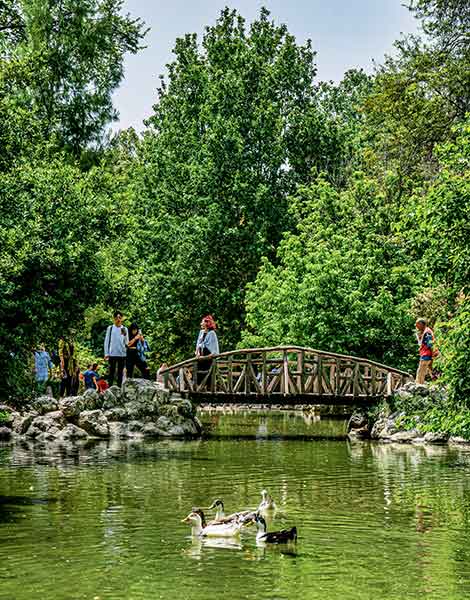
The National Garden – a stone’s throw away from the Greek Parliament.
© Perikles Merakos
Our next stop is on Lisiou Street – a mere 550 meters from St. Paul’s Church – at the inviting Melina Café (2nd stop). Here, you’ll find walls adorned with photographs of the celebrated Greek actress and politician Melina Mercouri (1920–1994), tracing her illustrious life and career. A legendary icon in Greece, this actress starred in the internationally acclaimed film “Never on Sunday” (1960), directed by Jules Dassin, which propelled her to global fame with an Oscar nomination and the Best Actress award at the Cannes Film Festival. A few years earlier, another of her iconic films, “Stella,” directed by Michael Cacoyannis, was filmed right in the heart of Plaka. Mercouri traveled to Cannes for its official screening, marking the beginning of her life-altering encounter with Dassin, her future husband and mentor. Today, the pair rest in eternal peace in the First Cemetery of Athens.
After an invigorating Greek coffee, it’s time to stroll down one of the oldest streets in Europe, Tripodon Street (3rd stop), just 150 meters from Melina Café. This historical road has stood the test of time, preserving its name and its general layout for an incredible 25 centuries! From here, a short, leisurely walk of 250 meters will bring you to Kydathineon Street (4th stop), where you’ll come face-to-face with the city’s vibrant, tourist-centric persona. As you amble between charming jewelry stores and shops stocked with unique souvenirs and exquisite linen clothes, you’ll be experiencing Athens in its lovely retail splendor.
Ascend the majestic Acropolis and then tour its museum (theacropolismuseum.gr), both absolute must-sees when in Athens. We recommend setting aside at least half a day for these awe-inspiring attractions.
The same goes for the National Archaeological Museum (namuseum.gr), the largest in Greece and one of the most important repositories of antiquities in the world. Lose yourself in the splendors of ancient Greece and make your Athenian adventure unforgettable.
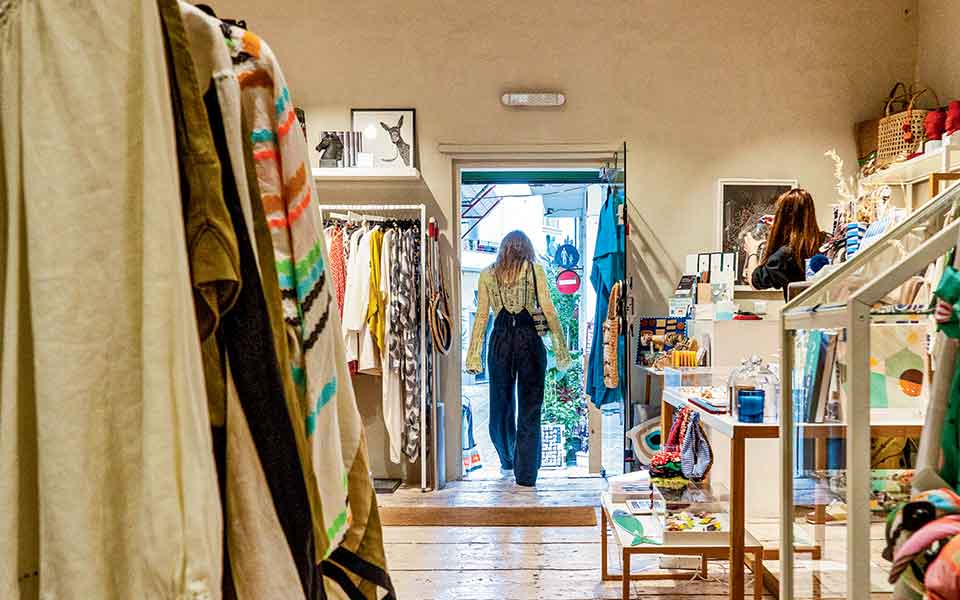
For souvenirs and summer garments head to Forget Me Not store in Plaka.
© Perikles Merakos
For your shopping escapade, we have a couple of delightful recommendations. The first is Forget Me Not at 100 Adrianou Street (5th stop), a store with charming trinkets and treasures. Our second suggestion is the concept store Mouki Mou Athens at 15 Diogenes (6th stop). This retail sanctuary is a new beacon of luxury shopping in the city, boasting a rich selection of clothing, jewelry, ceramics, and stunning decorative items. With a refined mix of international and Greek niche brands, it’s a one-stop shop for discerning shoppers.
To continue your cultural adventure, call upon your trusty GPS once more to locate the Lantern of Diogenes (7th stop). Officially referred to as the Monument of Lysicrates, this fascinating monument is a mere 450 meters away from Mouki Mou. Dating back to 335-334 BC, this time-honored testament to Greek antiquity is acknowledged as the best-preserved choragic monument of its era, and is a sight to behold indeed.
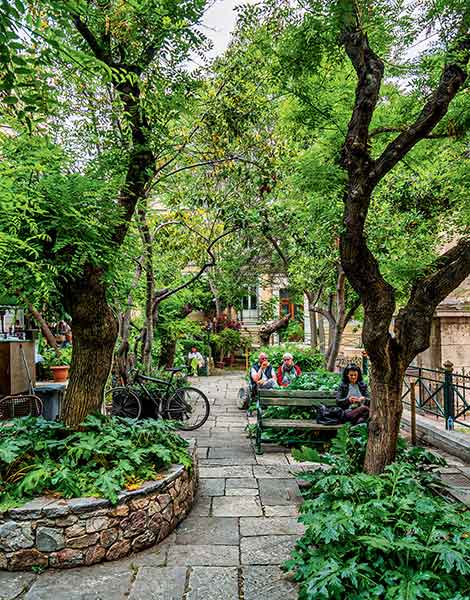
Greenery in Plaka
© Perikles Merakos
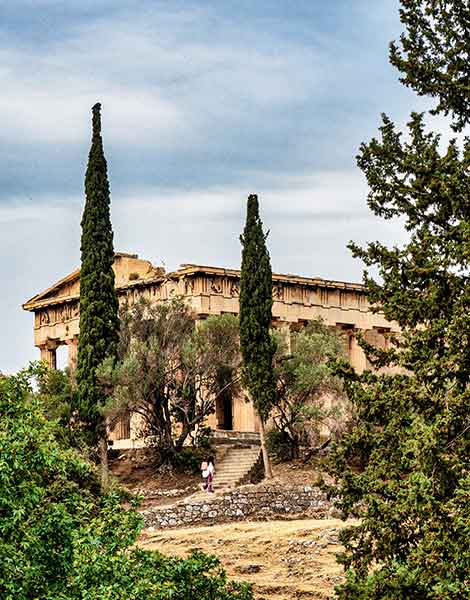
The Doric Temple of Hephaestus
© Perikles Merakos
Next, point your compass towards one of the city’s truly unique architectural jewels, the Tower of the Winds (8th stop). Tucked within the confines of the Roman Agora, it is a brief seven-minute walk from the Monument of Lysicrates. Also known as the Horologion of Andronikos Kyrrhestes, the structure is believed to have been constructed in the first half of the 1st century BC by its namesake, Andronikos Kyrrhestes, a noted ancient Greek engineer, astronomer, and architect.
Standing twelve meters high, this octagonal marble structure is considered the world’s oldest meteorological and horological station. Its metopes, richly adorned with relief carvings, bear figures depicting the eight winds; these carvings earned it the moniker “Tower of the Winds.” This historical treasure, which once housed an ancient water clock, is a testament to the ingenious craftsmanship of ancient Greek culture and is not to be missed.
Your Athenian odyssey continues as you walk to Monastiraki and its bustling square. Here, take a leisurely amble through the Ancient Agora (9th stop), a mere 450 meters from the Tower of the Winds. This breathtaking site is home to the Temple of Hephaestus, also fondly known as the Theseion; this edifice is the best-preserved ancient Greek temple in existence, and its enduring beauty is a marvel to behold.
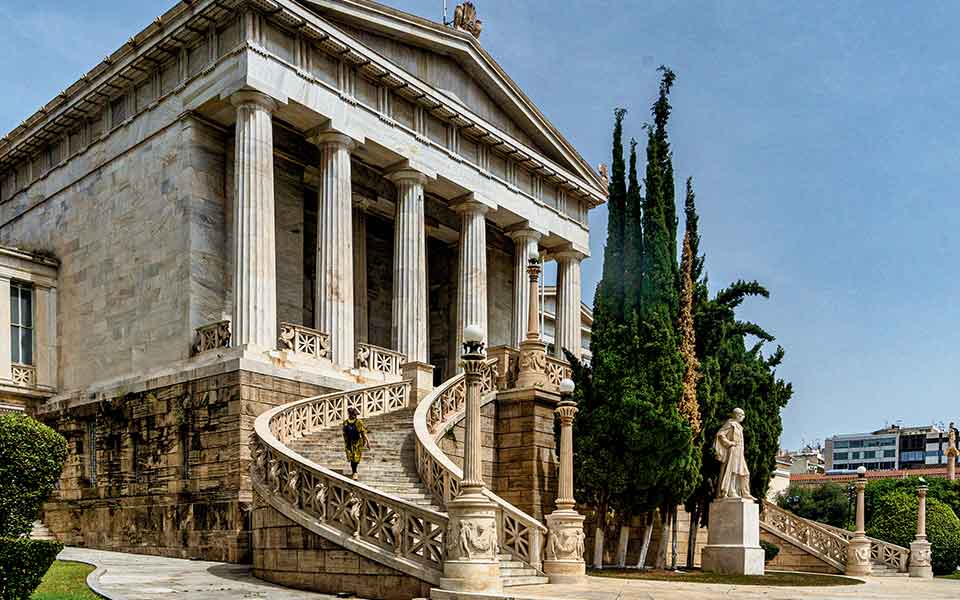
The central building of the Athenian Trilogy houses the Office of the Dean of the University of Athens.
© Perikles Merakos
Should you feel hungry, head across Monastiraki Square and down Athinas Street towards Omonia Square. Just 150 meters off to your right, you’ll find quaint and narrow Vissis Street. Here you’ll discover the chic vineria, Wine is Fine (6 Vissis, 10th stop), offering classic international dishes and a selection of natural wines. Once upon a time, this part of the city was a commercial hub, and each small street or block had its specialization, such as doorknobs, fabric or rattan ware. However, the process of gentrification has all but snuffed them out, making their charm all the more precious. Your stop here, then, isn’t just for refreshment; it’s an opportunity to experience an ever-dwindling slice of Athens’ historical urban fabric.
Alternatively, if your taste buds yearn for a local delicacy, you could set your course for nearby Aghias Irinis Square, for the legendary souvlaki from Kostas (11th stop).
From here, head down nearby Aiolou Street and onto Chrysospiliotissis Street. Crossing Praxitelous and heading for Evripidou, you’ll land in Aghion Theodoron Square, named after the 11th-century Byzantine church there. Once you’ve passed this historical site, you’ll find yourself in Klafthmonos Square, where the formidable stature and simple lines of the eight-meter-high Monument of National Reconciliation, an impressive piece by Greek sculptor Vassilis Doropoulos, have dominated the small park here since 1989.
Continuing north, your journey will take you across Stadiou Street and Korai Square, eventually bringing you to Panepistimiou Street. This section of the stroll skirting the city’s main arteries should take around ten minutes if you saunter leisurely, allowing the vibrant city life to distract you on your way.
A home for architectural elegance, Panepistimiou Street is celebrated for the “Athenian Trilogy,” three of the city’s most exquisite neoclassical buildings (12th stop).
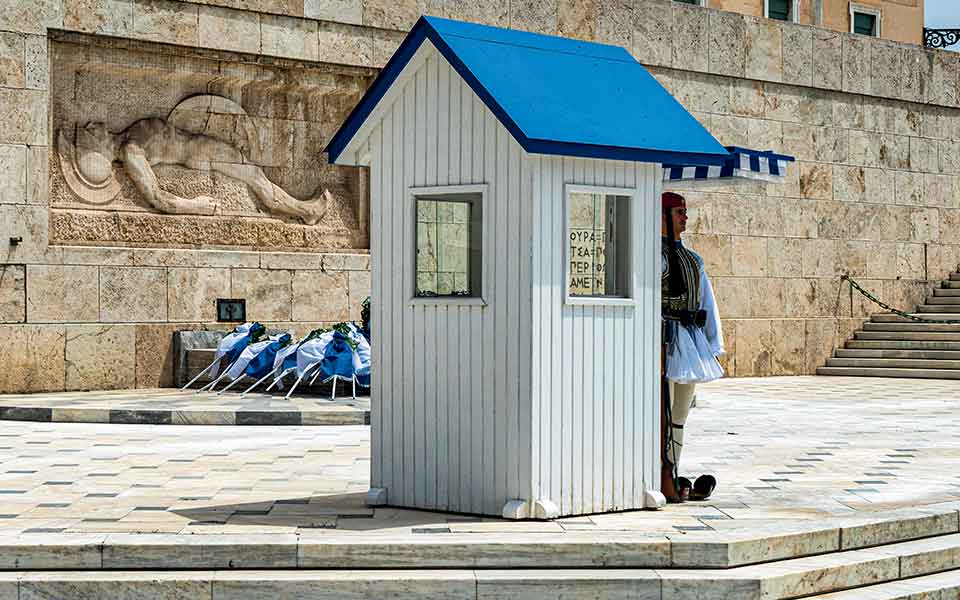
An Evzone stands guard at the Tomb of the Unknown Solider in front of the Greek Parliament.
© Perikles Merakos
Facing the buildings from Panepistimiou Street, you’ll see the majestic Vallianos Mansion with its sweeping marble staircase on your left. This building housed the National Library until 2017, when its treasures were relocated to the Stavros Niarchos Foundation Cultural Center. In the center, standing as a testament to Greek academia, is the erstwhile University of Athens, presently housing the office of the dean of the university. On your right, you’ll spot the Athens Academy Building, a symbol of intellectual pursuit and knowledge. Interestingly, both the Vallianos Mansion and the Athens Academy Building were the creations of Theophil Hansen, the brother of Hans Christian Hansen, who supervised the construction of the Church of St. Paul – your first stop on this memorable journey.
Why not capture this architectural grandeur within a single frame? Take out that cellphone, snap a panoramic shot of all three buildings, and ta-da! You’ve just crafted your own Athenian postcard. Just 300 meters away is Syntagma Square. However, before you head there, you might want to make a quick stop at the Benaki Shop on Kriezotou Street (13th stop), conveniently located next to the entrance of the Nikos Hadjikyriakos-Ghika Gallery. Here, you’ll discover elegant items primarily inspired by the rich collections of the Benaki Museums.
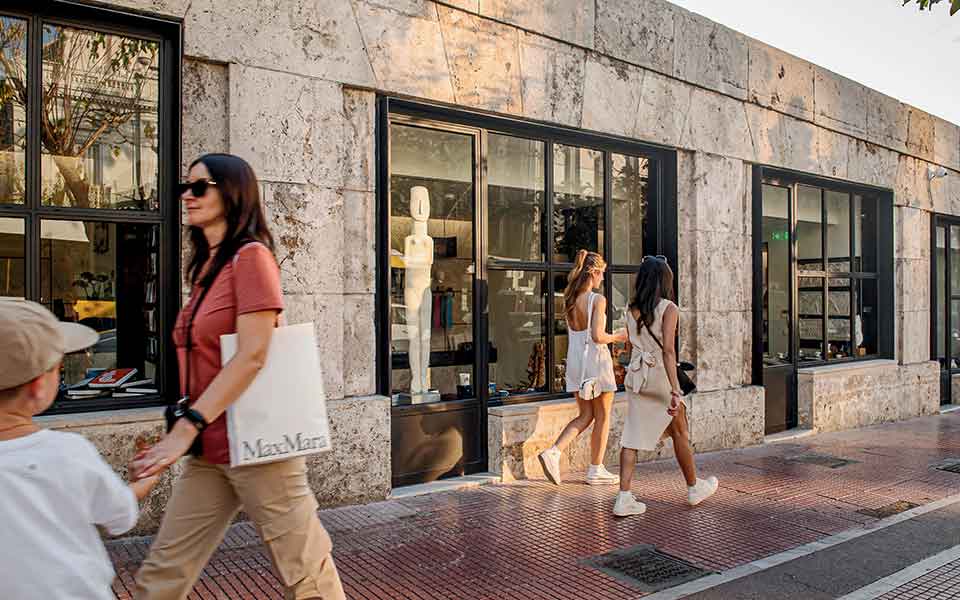
The Hellenic Heritage Showroom by the Parliament building.
© Perikles Merakos
Close by is the newly opened shop of the Cultural Resources Management and Development Organization (14th stop), also known as the Hellenic Heritage Showroom, at the start of Vasilissis Sofias Avenue, adjacent to the Parliament building. This shop offers faithful replicas of museums around the country and books on Greek culture in various languages. It stands in a charming spot fondly called Louloudadika (“Flower Shops”), for the small florists that thrived here in the 1930s, catering to the tradition of laying flowers at the nearby Tomb of the Unknown Soldier in front of the Parliament building. A few of these flower shops have since reopened, bringing back color and floral scents to this historical area.
Heading east on Vasilissis Sofias Avenue, you’ll encounter a stretch of fascinating museums – do remember to check their opening hours in advance. Within a leisurely stroll from each other lie the Benaki Museum of Greek Culture (1 Koumbari, 500 meters from Syntagma), housing exhibit items tracing the course of Greek culture from prehistoric times to the 20th century (15th stop), and the Museum of Cycladic Art (4 Neofytou Douka, approximately 200 meters from the Benaki). At the latter, you can explore the ancient world of the Cycladic civilization of the 3rd millennium BC (16th stop).
Next, let your feet guide you down elegant Herodou Attikou Street, which houses the Maximos Mansion, the office of the country’s Prime Minister. With the National Garden on your right, continue towards Pangrati to dine at the brand-new culinary sensation, the restaurant Akra (12 Aminta Street, 17th stop), an 8-minute walk away. The menu celebrates organic products cooked over open fire and charcoal; it emphasizes the raw materials and the chefs’ role as curators of nature’s bounty rather than as creators of complex recipes.
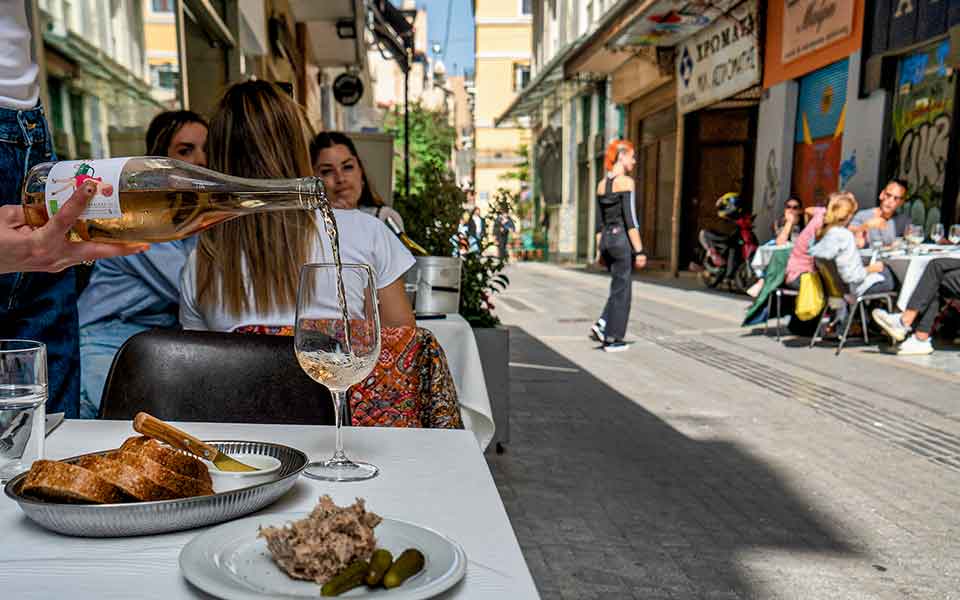
Tipple time at the aptly named Wine Is Fine.
© Perikles Merakos
Should you wish to extend your cultural journey, you can visit the National Art Gallery – Alexandros Soutsos Museum (50 Vasileos Konstantinou Avenue, 18th stop) or the Basil & Elise Goulandris Foundation (13 Eratosthenes Street, 19th stop); the latter focuses on more recent and contemporary art by both Greek and foreign artists, featuring works by Tsarouchis, Takis, Chryssa, Cézanne, Degas, Rodin, Toulouse-Lautrec, Picasso, Miro, Giacometti, Bacon, Lichtenstein, and more.
If you’ve indulged in enough art for the day, it’s time to treat yourself to a bit of sweetness! Just 250 meters uphill from the Basil & Eliza Goulandris Foundation Museum, tucked away at 2 Eftychidou Street, you’ll discover the Galaktoboureko Triantafyllou (20th stop). Here, you can taste what may well be the finest rendition of the traditional dessert from which the shop takes its name – “galaktoboureko” is a custard pie. Get it to go in a box to enjoy later – the crunchy, delicate filo and the semolina cream exude hints of vanilla, and it’s all bathed in citrus-infused syrup.
Leaving the charming neighborhood of Pangrati behind, head back down Eratosthenes Street towards Vasileos Konstantinou. Take a left when you reach that main thoroughfare, and you’ll soon find yourself in the presence of the magnificent Kallimarmaro (or Panathenaic) Stadium. Initially erected as a hippodrome in the 6th century BC, this impressive venue was rebuilt to host the first modern Olympic Games in 1896. Crossing Vasileos Konstantinou Avenue will lead you back into the inviting verdant embrace of the National Garden, bringing your journey full circle to where you began. If you still have some energy to spare, we recommend ending your day by watching a movie at the open air Cine Aigli (21st stop). This is the perfect way to savor your quintessential Athenian summer experience before returning to your hotel.
Why not end your day with a drink? Call a taxi – you’ve undoubtedly had more than enough walking – to cover the kilometer that will take you to the doorstep of Baba au Rum (6 Klitiou). Included in The World’s 50 Best Bars list, this swanky establishment serves divine cocktails, promising a fitting finale to your day.
• Redd – Try the best espresso in Kolonaki.
• Birdman – Experience yakitori fusion and creative cocktails.
• Oinoscent – Discover great wines from around the world.
• Tanpopo – Sup on ramen crafted by a master.
• Sushi Lunchi – Get some sushi in your rice bowl.
• Django – Indulge in the finest fig gelato you’ve ever tasted.
• Kora Bakery – Their artisanal croissants are full of buttery goodness.
• Kaya – Grab some specialty coffee to go.
• Wild Souls – There’s no sugar, palm oil or preservatives used here.
• Holly Llama – Stop in here for vegan delicacies.
• Epik Gelato – Have you ever had ice cream with breadcrumbs?
• Cookoovaya – A head-to-tail approach goes Greek.
• Kyrios – Your drink comes with a soundtrack.
• Οikonomou – Greek cuisine reigns supreme.
• Blame the Sun – Cool off with refreshing beers on tap.
• Benaki Café – Art, snacks, and impressive views converge.
• Naxos Apothecary – Embrace the wisdom of nature through their holistic approach to beauty.
From historic landmarks to edgy street...
The Goethe Institute's exhibition explores Athens'...
Antiques expert and collector Dimitris Xanthoulis...
Souvlaki joints started appearing in earnest...